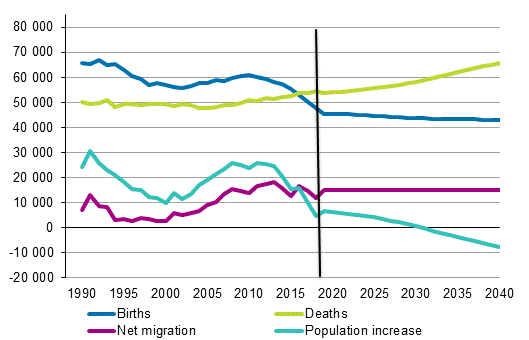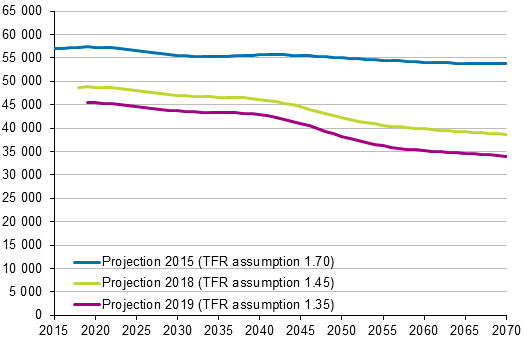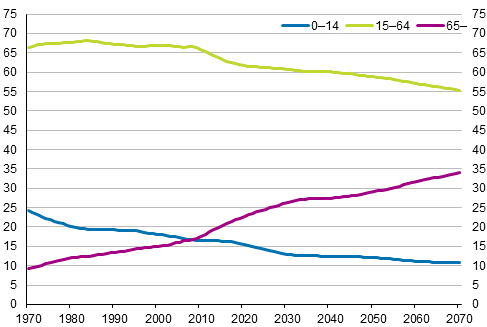Published: 30 September 2019
The decline in the birth rate is reflected in the population development of areas
According to Statistics Finland's latest population projection, if the birth rate remains at the current level there will be no regions in Finland where births exceed deaths in 15 years. Based on the current development, Finland’s population will start decreasing in 2031. In 2050, the population would be some 100,000 lower than today.
Births, deaths, net immigration and population change in 1990 to 2018 and projection for 2019 to 2040

In 2040, the population in Mainland Finland will only grow in the region of Uusimaa
In 2018, the population increased in four regions and in Åland. According to the projection, the population would only grow in the regions of Uusimaa and Pirkanmaa, and in Åland in 2035. In 2040, the population in Mainland Finland would only grow in the region of Uusimaa and even there only due to migration gain.
In 2018, there were 60 municipalities in Finland where births exceeded deaths. According to the projection, there would be 35 municipalities in Finland where births would exceed deaths in 2030 and by 2040 only 12.
Assumptions of the 2019 population projection
Statistics Finland's latest population projection assumes that the birth rate would remain constant in future. The imputed number of children that women give birth to during their lifetime, i.e. the total fertility rate is assumed to be 1.35. The assumption is drastic but reflects the current birth rate. According to the preliminary statistics, total fertility is estimated to be 1.32 to 1.34 in Finland in 2019.
The birth rate assumption has been higher in previous
projections and they contribute to the picture of what the
population development would be like if the birth rate would be
higher.
(
Population by age and sex in population projections for different
years, whole country )
Birth projection based on the projections made in 2015, 2018 and 2019

The projection assumes that Finland’s annual migration gain from abroad will be 15,000 persons.
Mortality is assumed to continue declining similarly to what has been detected when comparing the mortality for 1987 to 1991 and 2014 to 2018. The life expectancy of men is estimated to rise by good five years and that of women by close on four years by 2040. More detailed information about the forecasting method can be found in the quality description.
Comparison with previous projections
When comparing the 2019 population projection with the ones made in 2015 and 2018 the biggest differences, in addition to the population development, are seen in the projected development of young people in the short term and of the working age population in the long term.
According to the 2019 projection, the number of persons aged under 15 would be 688,000 in 2040 which is 178,000 less than in the 2015 projection and 47,000 less than in the 2018 projection.
The number of the working age population (aged 15 to 64) was highest in Finland in 2009, when there were 3.55 million such persons. During 2010 to 2018, the number of working-age people has fallen by 122,000 persons. During the next two decades, the working age population is expected to decrease more slowly or by 111,000 persons by 2040.
The reduction in the number of working age people would accelerate in the 2040s due to a drop in the birth rate. During 2041 to 2050, the working age population would decrease by 132,000 persons and in 2051 to 2060 further by 163,000 persons. At the end of 2060, the working age population would be 3.19 million persons, which is good 400,000 fewer than currently.
Age groups’ share of the population 1970–2018 and projected share 2019–2070, per cent

The proportion of working age people in the population is currently 62 per cent. According to the projection, the proportion will drop to 60 per cent by 2040 and to 57 per cent by 2060. In the 2019 projections, the proportion of people of working age in total population is higher than in the two previous projections until 2060 because the population makes a downturn earlier due to the lower birth rate.
The projection is a trend calculation and gives decision-makers a chance to react
Statistics Finland’s population projections are demographic trend calculations based on observations on past development in the birth rate, mortality and migration. The projections do not seek to estimate the effect of economic, socio-political regional policy and other such factors on population development.
According to the character of trend calculations, the projection expects past developments to continue into the future. The projections do not take a stand on how the size of the population should develop. Therefore, population projection figures should be examined bearing in mind that the projection only indicates the expected population development if the past development continues unchanged into the next decades.
The task of a population projection is to provide tools with which decision-makers can assess whether measures need to be taken to try to influence the population development. Decision-makers should assess the advisability of the population development indicated by the projection and, if necessary, take action to prevent the materialisation of the projection if the population development indicated by the projection is not desired.
The projection has been made for the whole country up to
2070 and regionally up to 2040.
The next population projection will be published in autumn
2021.
Statistics Finland's population projections always include a
regional projection, unless otherwise indicated.
Source: Population and Justice Statistics. Statistics Finland
Inquiries: Markus Rapo 029 551 3238, vaesto.tilasto@stat.fi
Director in charge: Jari Tarkoma
Publication in pdf-format (302.0 kB)
- Tables
-
Tables in databases
Pick the data you need into tables, view the data as graphs, or download the data for your use.
Appendix tables
- Figures
-
- Appendix figure 1. Demographic depedency ratio 1970 - 2060 (30.9.2019)
- Appendix figure 2. Total fertility rate 1960 - 2019* (30.9.2019)
- Appendix figure 3. Population by age 1900 - 2018 and projection 2019 - 2070 (30.9.2019)
- Appendix figure 4. Population by age and gender 2018 (30.9.2019)
- Appendix figure 5. Population by age and gender 2040, projection 2019 (30.9.2019)
- Quality descriptions
Updated 30.9.2019
Official Statistics of Finland (OSF):
Population projection [e-publication].
ISSN=1798-5153. 2019. Helsinki: Statistics Finland [referred: 17.12.2025].
Access method: http://stat.fi/til/vaenn/2019/vaenn_2019_2019-09-30_tie_001_en.html

